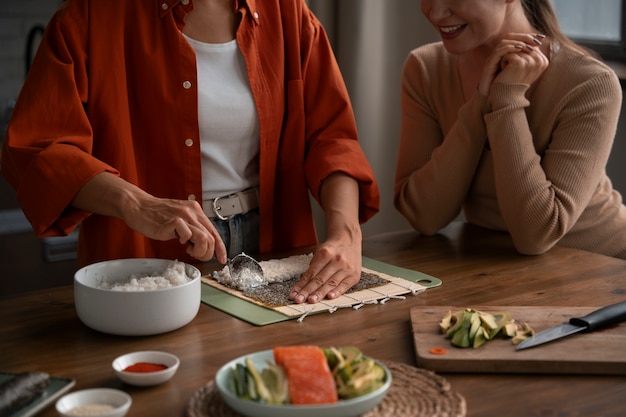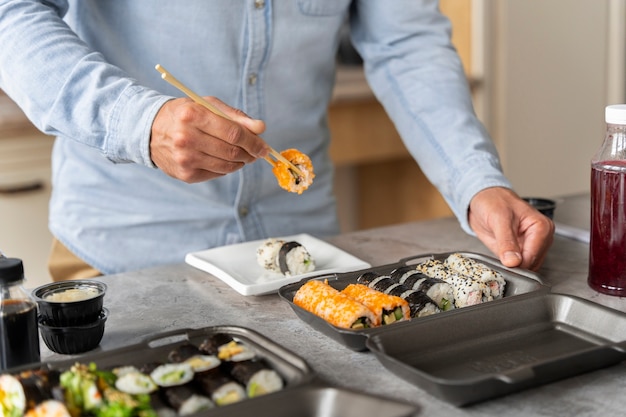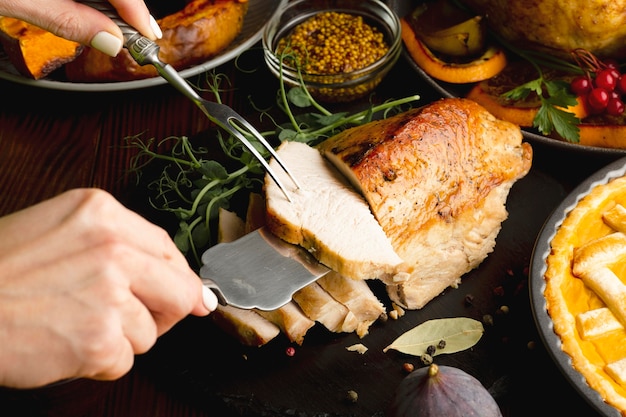(Part 1) Choosing Your Salmon Superstar

Salmon Varieties: A Taste of the World
- wild salmon: This is the real deal. Think rich, robust flavours and a firm texture that holds its shape. It's a treat, but can be a little pricier.
- farmed salmon: A more affordable option, farmed salmon is still delicious, but it might have a gentler flavour compared to its wild counterpart.
- atlantic salmon: You'll find this salmon in most supermarkets, making it a reliable choice. Its taste and texture can vary depending on its origin and the farming practices, so do a little research!
- sockeye salmon: This salmon boasts a deep red flesh and intense, rich flavour, making it a step above the Atlantic salmon. It's a real delight, but might be harder to find.
- King Salmon: Also known as chinook salmon, this king of the salmon family is the largest and boasts the richest flavour. A real treat for a special occasion!
Freshness: The Key to Success
When choosing your salmon, look for bright, shimmering skin and a fresh, slightly salty scent. Avoid any fish that smells strongly of ammonia or feels mushy to the touch. Don't be shy – ask the fishmonger for advice! They're the experts and can help you pick the best salmon for your culinary adventure.(Part 2) Prepping Your Salmon for Oven Glory

Skin On or Off? The Great Debate
This is a personal choice, but I generally prefer cooking salmon with the skin on. It helps keep the fish moist and prevents it from sticking to the baking sheet. If you're worried about the skin being a bit tough, you can always remove it after cooking.Seasoning Salmon: A Symphony of Flavours
This is where your creativity takes centre stage! Here are some of my favourite seasonings to elevate the taste of salmon:- Salt and Pepper: The classics for a reason! These enhance the natural flavours of the salmon.
- Lemon Pepper: This adds a bright and zesty punch, perfectly complementing the richness of salmon.
- Fresh Herbs: Fresh herbs like dill, thyme, rosemary, and parsley are a must for adding an aromatic touch. A sprinkling of chopped fresh herbs just before serving is a delightful final touch.
- Garlic: A sprinkle of garlic powder or a few cloves of fresh garlic adds a touch of warmth and umami.
- Smoked Paprika: For those who enjoy a hint of smokiness, smoked paprika adds a depth of flavour that complements the salmon beautifully.
Glazing for an Extra Touch of Indulgence
Glazing is a fantastic way to add a touch of sweetness and richness to your salmon. You can use store-bought glazes or create your own, unleashing your inner chef! Here are some popular options:- Honey Glaze: A beautiful combination of honey, soy sauce, and ginger creates a sweet and savoury glaze that complements the salmon perfectly.
- maple glaze: Maple syrup, mustard, and a hint of balsamic vinegar combine to create a tangy glaze that's both delicious and sophisticated.
- Teriyaki Glaze: A store-bought teriyaki sauce or a homemade version with soy sauce, mirin, and sugar will give your salmon a delightful Asian flavour profile.
(Part 3) The Oven's Role in Salmon Perfection

The Baking Sheet: Simple and Versatile
This is the easiest and most versatile method, ideal for individual fillets or whole salmon.- Preheat Your Oven: Preheat your oven to 400°F (200°C).
- Line Your Baking Sheet: Line a baking sheet with parchment paper for easy clean-up and to prevent sticking.
- Arrange the Salmon: Place your salmon fillets or whole salmon on the prepared baking sheet, ensuring they have some space between them.
- Bake to Perfection: Bake for 12-15 minutes, or until the salmon is cooked through.
The Oven-Safe Pan: Amplifying Flavour
This method is a fantastic option for creating a more intense flavour, as the salmon cooks in its own juices, enhancing its natural goodness.- Preheat Your Oven: Preheat your oven to 375°F (190°C).
- Grease Your Pan: Grease an oven-safe pan with cooking spray or butter.
- Place the Salmon: Place your salmon fillets or whole salmon in the prepared pan.
- Bake to Deliciousness: Bake for 15-20 minutes, or until the salmon is cooked through.
En Papillote: A Culinary Enchantment
This elegant French technique involves cooking the salmon in parchment paper, creating a moist and flavourful environment by trapping steam.- Prepare the Parchment Paper: Cut out squares of parchment paper large enough to wrap the salmon comfortably, with some room for folding.
- Layer with Ingredients: Place the salmon fillets, vegetables (if using), and seasonings in the center of the parchment paper. Feel free to add herbs, lemon slices, or other flavourful ingredients.
- Fold and Seal: Fold the edges of the parchment paper over the salmon, creating a neat parcel, and seal tightly.
- Bake to Perfection: Bake for 15-20 minutes, or until the salmon is cooked through.
(Part 4) The Art of Judging salmon doneness
Here comes the tricky part – knowing when your salmon is cooked perfectly. You don't want it overcooked, but you need to ensure it's safe to eat.The Fork Test: A Classic Method
Gently insert a fork into the thickest part of the salmon. If it flakes easily, it's cooked. If it feels firm and resistant, it needs a few more minutes.The internal temperature Test: Scientific Accuracy
For those who prefer precision, use a meat thermometer. Cooked salmon should reach an internal temperature of 145°F (63°C) to 165°F (74°C).The Appearance Test: Visual Clues
Look for a change in the salmon's color. It should transform from translucent to opaque, with a slightly whitish hue. The flesh should also appear flaky, indicating it's cooked through.The "Finger" Test (for Whole Salmon): A Simple Touch
Gently press your finger into the thickest part of the whole salmon. If it feels springy, it's cooked. If it feels mushy, it needs more time.(Part 5) salmon cooking Time Chart: A Quick Reference
To make things even easier, here's a handy chart showing approximate cooking times for different salmon sizes. Remember, this is just a guideline, so always check for doneness!| Salmon Size | Oven Temperature | Cooking Time |
|---|---|---|
| 4-ounce fillet | 400°F (200°C) | 10-12 minutes |
| 6-ounce fillet | 400°F (200°C) | 12-15 minutes |
| 8-ounce fillet | 400°F (200°C) | 15-18 minutes |
| 10-ounce fillet | 400°F (200°C) | 18-20 minutes |
| Whole salmon (3-4 pounds) | 375°F (190°C) | 20-25 minutes |
(Part 6) Resting for a More Exquisite Flavour
Once your salmon is cooked, don't rush to devour it! Let it rest for a few minutes before serving. This allows the juices to redistribute, resulting in a moister, more flavorful fish.(Part 7) Salmon's Perfect Partners: Serving Suggestions
Salmon's versatility allows it to be paired with an endless variety of sides. Here are some ideas to spark your culinary creativity:Simple yet Delicious Sides
- Roasted Vegetables: Asparagus, broccoli, Brussels sprouts, carrots, and potatoes are all fantastic roasted with salmon, bringing a burst of colour and flavour to your plate.
- Rice: Plain white rice or brown rice are excellent for soaking up the delicious pan juices, adding a touch of comfort to the meal.
- Salad: A simple green salad with a light vinaigrette dressing adds freshness and balances the richness of the salmon.
More Adventurous Sides
- Lemon Herb Couscous: This adds a burst of zesty freshness and complements the salmon perfectly.
- roasted sweet potatoes: sweet potatoes add a touch of sweetness and a beautiful contrast in colour, making your dish both delicious and visually appealing.
- Creamy Spinach: Sauté spinach with garlic and cream for a rich and flavourful side that pairs beautifully with the salmon.
(Part 8) Storing leftover salmon: Making the Most of It
If you have leftover salmon, store it in an airtight container in the refrigerator for up to 3 days. Enjoy it cold in salads or sandwiches or reheat it in the oven or microwave.(Part 9) Salmon Oven cooking tips: Unlocking Culinary Secrets
Here are a few more tips to ensure your salmon is cooked to perfection, turning your kitchen into a salmon haven:- Don't Overcrowd the Pan: Give the salmon fillets ample space to cook evenly, preventing them from steaming instead of browning.
- Avoid Flipping (unless Skinless): Unless you're using the skin-off method, avoid flipping the salmon during cooking. Flipping can break it apart and cause it to dry out.
- Pat Salmon Dry: Pat the salmon fillets dry with paper towels before seasoning and cooking. This helps the skin to crisp up and prevents steam from forming, allowing for better browning.
- Check for Doneness Early: It's always better to check for doneness a bit earlier than you think you need to, preventing overcooking.
- Let the Salmon Rest: As mentioned before, let the salmon rest for a few minutes after cooking to allow the juices to redistribute.
(Part 10) FAQs: Addressing Your Salmon Questions
Now, let's answer some of the most common questions about oven-cooked salmon, providing the answers you need to conquer your salmon cooking fears.1. Can I cook salmon Frozen?
Yes, you can cook salmon from frozen. Simply add a few minutes to the cooking time. Be sure to check for doneness earlier than usual.2. How Can I Keep Salmon Moist?
To keep salmon moist, cook it gently, avoid overcooking, and use moist cooking methods like en papillote.3. What Happens if I Overcook Salmon?
Overcooked salmon becomes dry and flaky, losing its delicious flavour and developing a rubbery texture.4. Can I Cook Salmon with Other Ingredients?
Absolutely! Salmon is a versatile fish that can be cooked with vegetables, herbs, spices, and even fruits. Get creative and experiment with different flavour combinations.5. What's the Best Way to Serve Salmon?
There's no one "best" way to serve salmon. It depends on your personal preference. You can serve it hot, cold, or at room temperature. Add different toppings, sauces, and sides to create your perfect salmon dish.Everyone is watching

Prime Rib Roast Cooking Time Chart: Per Pound Guide
Cooking TipsPrime rib roast. Just the name conjures images of lavish dinners, crackling fires, and hearty laughter. It’s ...

How Long to Bake Potatoes in the Oven (Perfect Every Time)
Cooking TipsBaked potatoes are a staple in my kitchen. They're incredibly versatile, delicious, and surprisingly easy to m...

Perfect Rice Every Time: The Ultimate Guide to Cooking Rice
Cooking TipsAs a self-proclaimed foodie, I've always been a bit obsessed with rice. It's the foundation of countless cuisi...

The Ultimate Guide to Cooking Asparagus: Tips, Techniques, and Recipes
Cooking TipsAsparagus. The mere mention of this spring delicacy conjures up images of vibrant green spears, crisp and burs...

Ultimate Guide to Cooking the Perfect Thanksgiving Turkey
Cooking TipsThanksgiving. Just the word conjures up images of overflowing tables laden with delicious food, the scent of r...
